The City of Lakes is it?

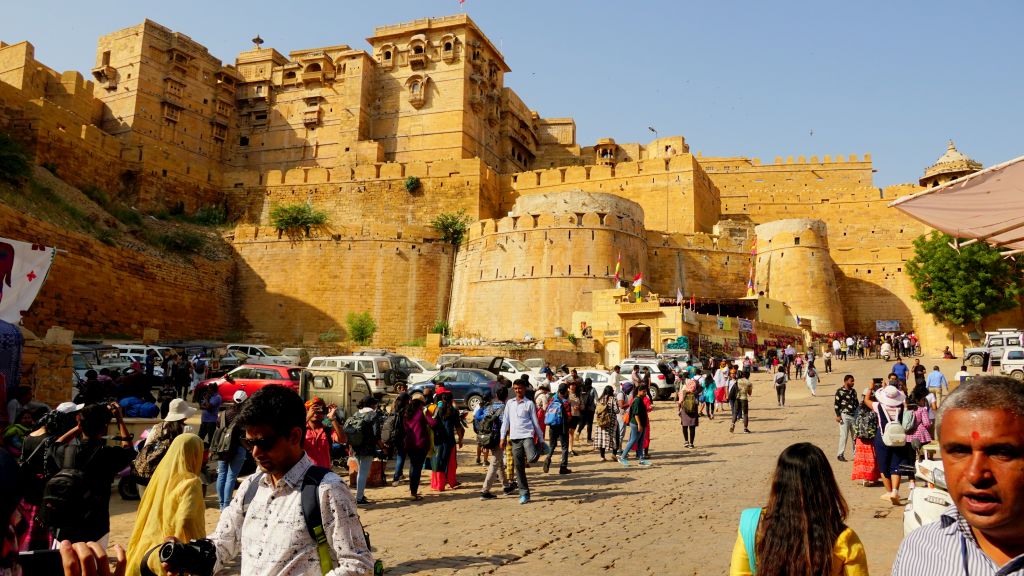
Long stories are hard to begin, especially the ones that leave a lasting impact. My journey with Explorarchi, through the streets of Jaipur, is a great example of the above statement. I was introduced to a hundred unknown faces at Kolkata Airport. Hardly had I known that these same people whose names I barely knew would come together to create one of the most memorable architectural tours of my life. The Journey began on the 18th of October, Friday at 3am in the morning. I hurriedly woke up to the and rechecked my belongings in preparation to the 10-day long journey ahead. By 4am already somewhat late I was jogging through the sleepy streets of my neighborhood to meet my team lead, Arnab Da, waiting in the cab that would take us to the airport.
Personally, it has always been quite a challenge for me to catch an early morning train or flight, having missed quite a few trains in the last 24 years of my life. Thus, it was very evident why I was extremely nervous for the task ahead. A group of a hundred students of Amity University Architecture department would be gathering there along with three of their teachers. There was to be thorough attendance call, distribution of tickets, checking in everyone’s luggage while ensuring nobody left behind their bags, the long line of security checks and finally the distribution of breakfast.
Despite the long list of tasks and the huge amount of co-ordination required between the explorArchi team members, everything thankfully went very smoothly. The entire group checked in with ample of time for the 8 am flight to Jaipur, allowing students free time to play around in the waiting lobby or enjoy breakfast while watching other flights take off.
DAY 1: CITY OF JAIPUR:-
On the itinerary – a) Albert Hall Museum, b) Jawahar Kala Kendra.
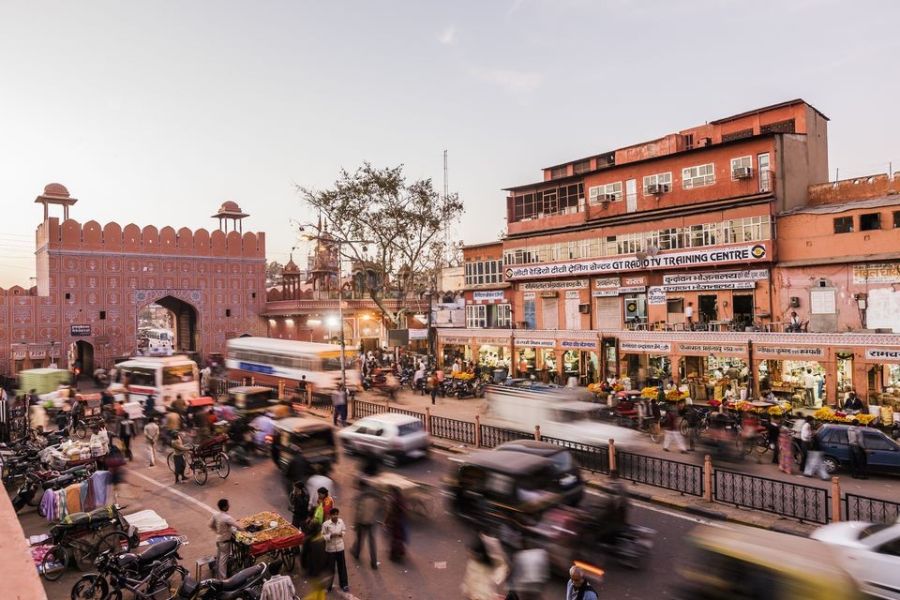
The image of the modern city of Jaipur constituting its texture, building facades, road networks and even the landscaping to a certain extent were extremely similar to that of any other developing capital cities of the country. There was a realisation the diversity the nation is so famous for as not found a way to reflect into the modern architecture that is currently practiced. It wasn’t until the day after when we finally ventured into the old city of Jaipur or the pink city as it’s popularly known as that finally found the touch of uniqueness and sense of place that architecture in Rajasthan is famous for. The city was built following the principles of Shilpa Shastra, the Indian Architecture.
The city was divided into nine blocks, of which two consist the state buildings and palaces, with the remaining seven allotted to the public. On the day that we arrived the first place on our list of architectural wonders was the Albert Hall Museum. After a light lunch of rice and chicken prepared by the teams own cook. We set of to visit one of the best examples of Indo Saracenic architecture in India. Travelling through the non-descriptive streets of Jaipur the Albert hall museum suddenly comes into view almost like a mirage in a desert. Situated at the center of the Ram Niwas Garden, the palace crowned with five large chhatris sits in perfect visual symmetry.
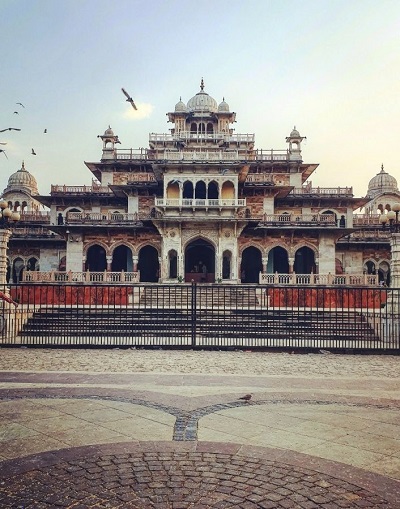 The monument was constructed in 1876 as an extravagant gesture by the Maharaja Sawai Madho Singh for one sole purpose, to ensure Prince Albert of England would visit Jaipur during his tour of the country. The Albert Hall was completed in 1887 by the architect Samuel Swinton Jacob, the chief architect Jacob had great respect for the local approach to art and architecture.
The monument was constructed in 1876 as an extravagant gesture by the Maharaja Sawai Madho Singh for one sole purpose, to ensure Prince Albert of England would visit Jaipur during his tour of the country. The Albert Hall was completed in 1887 by the architect Samuel Swinton Jacob, the chief architect Jacob had great respect for the local approach to art and architecture.
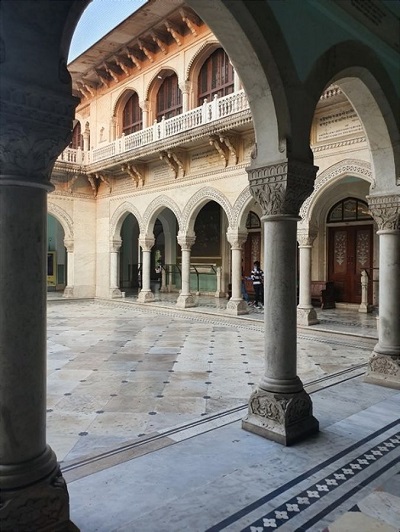
The elaborate ornamentation of the walls shined in the light of the setting sun. Our team head gave a detailed description its architectural features to the gathered students. The plan of the structure is simple with galleries of double height, arranged in a row, and together providing the main exhibition space. The galleries are surrounded by corridors. Centrally placed in front of them is a spacious hall intended for lectures and public meetings, flanked on either side by an open courtyard. European principals for design of institutions were followed. The details in the elevation and indigenous elements are what makes the building so special. The hall currently functions as a museum.
As I walked through the rooms of the hall, I realized that the best features of the museum were its courtyards. Corridor spaces lined with arches opens out to to give a glimpse of the pyramidical roof against the sky giving the space ample of natural light yet allowing its observers to sit in the shade.
As the last of the pigeons sitting of the chhatris of the albert hall flew off to return home it was also time for us to be off to our next destination, Jawahar Kala Kendra designed by one of the best architects of modern India- Charles Correa Jawahar Kala Kendra center of arts and crafts was built in the year 1986 and the construction completed in 1991. The center was launched by the state government to provide space to the cultural and spiritual values of India and display the rich craft heritage. The center is dedicated to the late prime minister of India Jawaharlal Nehru.
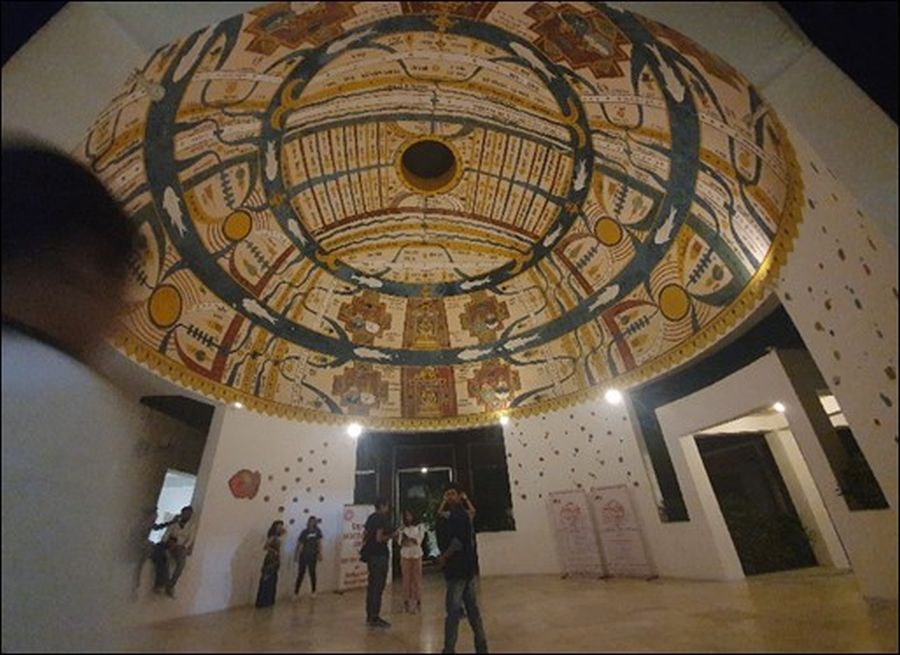 The Centre an analogue to Maharaja Jai Singh’s of the original city pIan of Jaipur. Correa's plan for the Kendra invokes directly the original Navagraha or nine house mandalas. The building program has been disaggregated into eight separate groupings. Each of the squares is de?ned by 8-metre-high walls. The plan of the structure delves deep into Hindu mythology, each square is represented by that particular planet, :for instance, the library is located in the square of the planet Mercury which traditionally represents knowledge, and the theatres are in the house of Venus, representing the arts. The central square, as speci?ed in the ‘Vastu Shastra’ is a void: representing the Nothing which is everything.
The Centre an analogue to Maharaja Jai Singh’s of the original city pIan of Jaipur. Correa's plan for the Kendra invokes directly the original Navagraha or nine house mandalas. The building program has been disaggregated into eight separate groupings. Each of the squares is de?ned by 8-metre-high walls. The plan of the structure delves deep into Hindu mythology, each square is represented by that particular planet, :for instance, the library is located in the square of the planet Mercury which traditionally represents knowledge, and the theatres are in the house of Venus, representing the arts. The central square, as speci?ed in the ‘Vastu Shastra’ is a void: representing the Nothing which is everything.
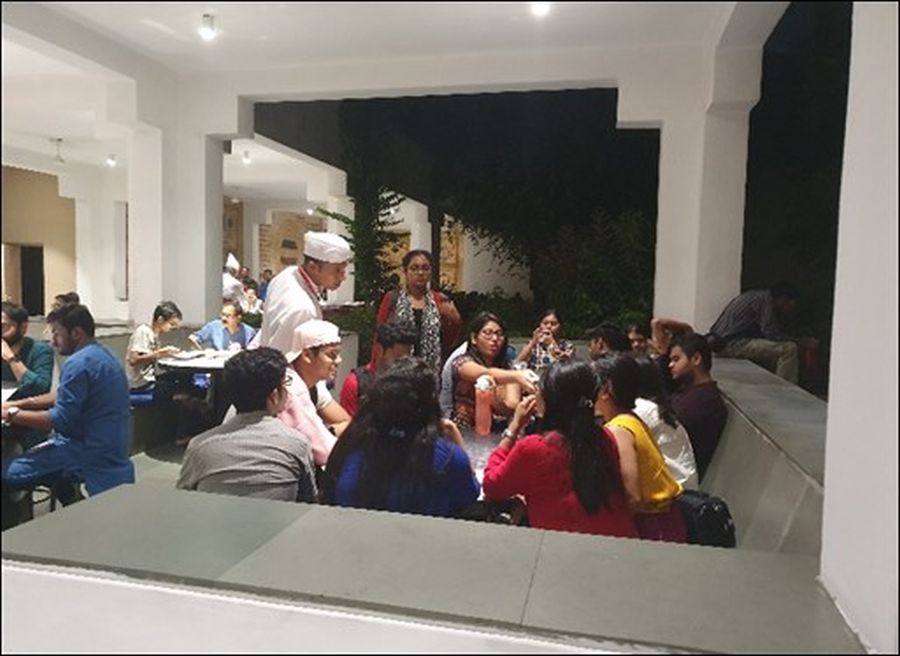
On reaching Jawahar Kala Kendra, after the long day’s journey everyone indulged themselves in some much-needed coffee and refreshments. While relaxing in the cafeteria we could hear music being played in one of the adjacent halls. As we ventured inside, we realized the this was in fact an open-air theatre. A stage had been set up where musicians were playing traditional folk music of Rajasthan. Several dancers took to the stage and showcased the different traditional styles of various regions of Rajasthan. We sat there mesmerized by their performances feeling extremely lucky about the perfect timing of visiting the place. Feeling re energized with the vibrant colorful performances we left the art and craft center looking forward to a much-needed long nights sleep for the next day ahead.
DAY 2: CITY OF JAIPUR:-
On the itinerary – a) Hawa Mahal, b) Amber Palace, c) Jaigarh fort, d) Jal Mahal
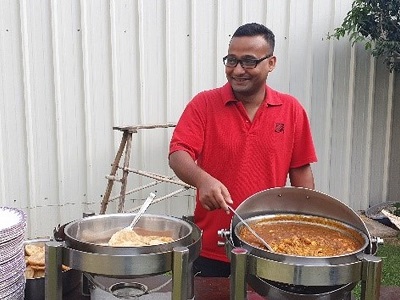 Hot tea and delicious kachoris served by the explorArchi food team greeted us at the courtyard of our hotel. The team’s academic head, an expert in conservation as well as town planning gave us a detailed brief of the monuments on our itinerary. We listened intently while munching on the sweet jalebis that were served with breakfast. By 10 AM all seated comfortably in our seats we travelled through the roads of the old city of Jaipur. Hawa Mahal with all its 945 jhrokhas was the most picturesque part of the city, making it a focal point of the market around it.
Hot tea and delicious kachoris served by the explorArchi food team greeted us at the courtyard of our hotel. The team’s academic head, an expert in conservation as well as town planning gave us a detailed brief of the monuments on our itinerary. We listened intently while munching on the sweet jalebis that were served with breakfast. By 10 AM all seated comfortably in our seats we travelled through the roads of the old city of Jaipur. Hawa Mahal with all its 945 jhrokhas was the most picturesque part of the city, making it a focal point of the market around it.
The road leading to the Amber palace located 11 kilometers away from the city’s borders is perfect for road trips dotted on each side with evergreen trees and flowering shrubs. Expect to catch a brief glimpse of the beautiful Jal Mahal built in the middle of the Mansagar lake on the uphill climb to the palace.
The amber palace looms over the assembled tourists, the massive structure a personification of grandeur and strength that can be achieved through architecture. The yellow sandstone wall creating a sharp contrast with its green and blue background of the trees and sky. Armed with umbrellas caps and sunscreen to combat the blazing Rajasthan sunshine we set out to explore the entire complex. 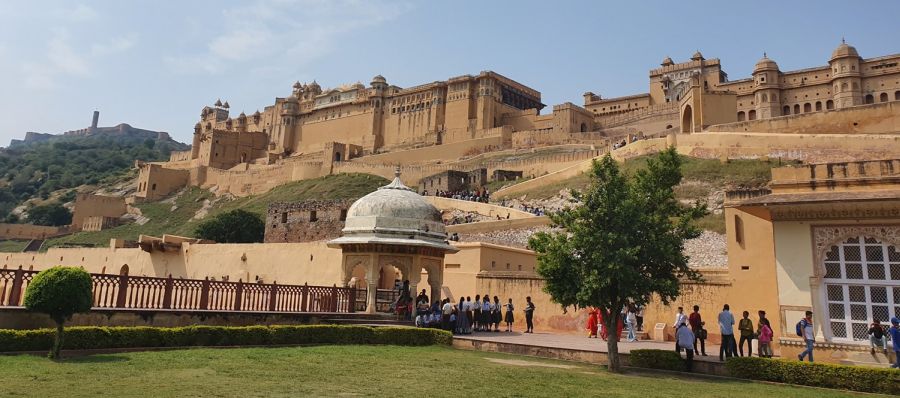 The structure has four different parts, each with a separate entrance. The main entry to the fort is through the 'Suraj Pol' which opens up into main courtyard. This east-facing gate is also the main entrance to the palace. The 'Jaleb Chowk' is one of the four courtyards of the Amer Palace. The 'Sila Devi' Temple is right at the entrance to the main palace grounds. The second courtyard is famous for its 'Diwan-i-Aam', the 'Sheesh Mahal' and the 'Sukh Mahal'
The structure has four different parts, each with a separate entrance. The main entry to the fort is through the 'Suraj Pol' which opens up into main courtyard. This east-facing gate is also the main entrance to the palace. The 'Jaleb Chowk' is one of the four courtyards of the Amer Palace. The 'Sila Devi' Temple is right at the entrance to the main palace grounds. The second courtyard is famous for its 'Diwan-i-Aam', the 'Sheesh Mahal' and the 'Sukh Mahal'
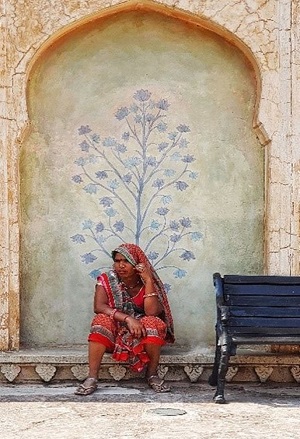 The palace giving an altogether image of rigidity is surprisingly full of delicate ornamental detailing. The ivory doors, mirror work on its walls, the symmetrical gardens all give an impression of economic abundance of the bygone era. By the time we were done we had an ample of instagrable pictures and a renewed respect for the architectural feat achieved by the Rajputs.
The palace giving an altogether image of rigidity is surprisingly full of delicate ornamental detailing. The ivory doors, mirror work on its walls, the symmetrical gardens all give an impression of economic abundance of the bygone era. By the time we were done we had an ample of instagrable pictures and a renewed respect for the architectural feat achieved by the Rajputs.
As the tired students and teachers made their way to back to the parking lot, the explorarchi food team were ready with packed lunch boxes and refreshments. Finally, in the shade of trees I sipped on my cool appy fizz I gazed up again at the amber palace, standing there like a timeless monument. Untouched in it’s grandeur. As I tried to memorize parts of it my heart filled with wonder about what human creativity and intelligence can truly achieve when need be.
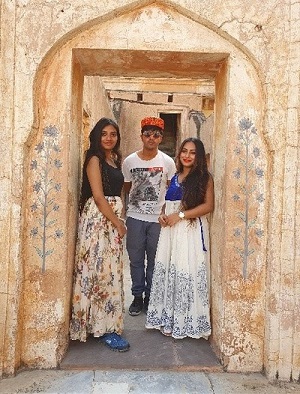 Having rested to our hearts fill at around 3:30 PM we made our way to the next destination: Jaigarh fort. This time however the tour bus was given a miss, instead the team lead booked jeeps to take us quickly and safely up the hilly roads. As we climbed up to the top of the hill to our delight, we spotted wild peacocks roaming in the forested areas along the road!
Having rested to our hearts fill at around 3:30 PM we made our way to the next destination: Jaigarh fort. This time however the tour bus was given a miss, instead the team lead booked jeeps to take us quickly and safely up the hilly roads. As we climbed up to the top of the hill to our delight, we spotted wild peacocks roaming in the forested areas along the road!
The Jaigarh Fort is a majestic stronghold built by Sawan Jai Singh II in 1726. It was in fact an extension of the Amber palace itself, and still to this day remains connected by an underground passageway. It was built to protect the Amer Fort and the palace within the complex, the Jaigarh Fort is architecturally similar to the Amer Fort and offers a panoramic view of the city of Jaipur
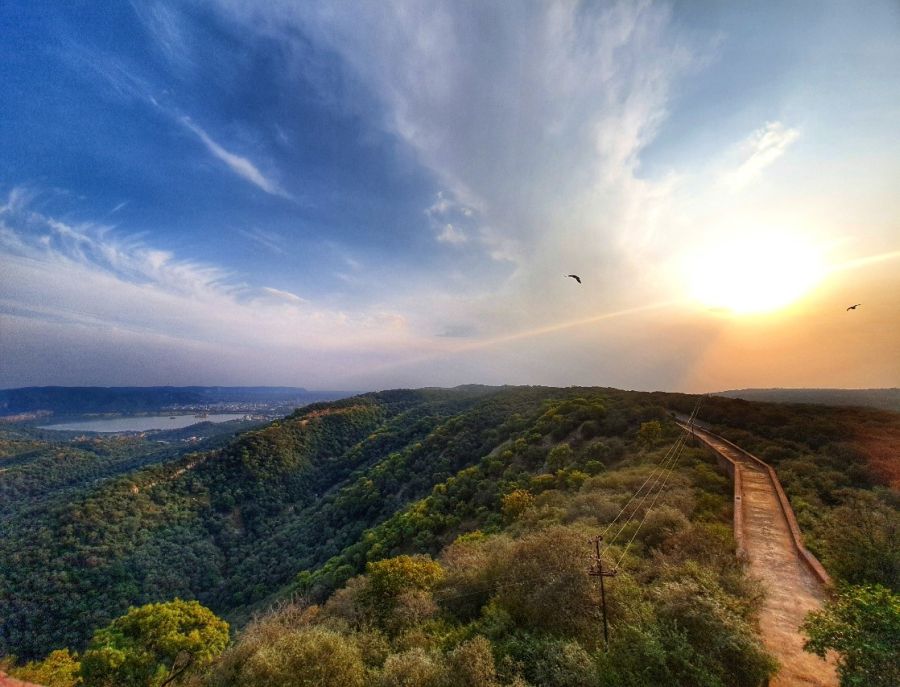 The jeeps dropped us right at the location of the fort’s main attraction -the world's largest cannon on wheels. The Fort is situated on top of Aravalli hill 400 meters up to the Amber Fort providing panoramic view of Jaipur city and creating the setting of one of the best sunsets of the tour. As we reached the middle of the Jaigarh fort, we stubbled on to a open air courtyard. The strong evening breeze and the dying light compelled us to rest our happily tired feet and engage in casual chatter. The open courtyard filled up with the sound of wind and laughter, I rested my head on a wall nearby and cheerfully listened to my colleges talk about the delicious biriyani to be served for dinner. I however was excited about something entirely different- I really couldn’t wait to go back to the old city of Jaipur where we would be given two-hour break to go shopping.
The jeeps dropped us right at the location of the fort’s main attraction -the world's largest cannon on wheels. The Fort is situated on top of Aravalli hill 400 meters up to the Amber Fort providing panoramic view of Jaipur city and creating the setting of one of the best sunsets of the tour. As we reached the middle of the Jaigarh fort, we stubbled on to a open air courtyard. The strong evening breeze and the dying light compelled us to rest our happily tired feet and engage in casual chatter. The open courtyard filled up with the sound of wind and laughter, I rested my head on a wall nearby and cheerfully listened to my colleges talk about the delicious biriyani to be served for dinner. I however was excited about something entirely different- I really couldn’t wait to go back to the old city of Jaipur where we would be given two-hour break to go shopping.
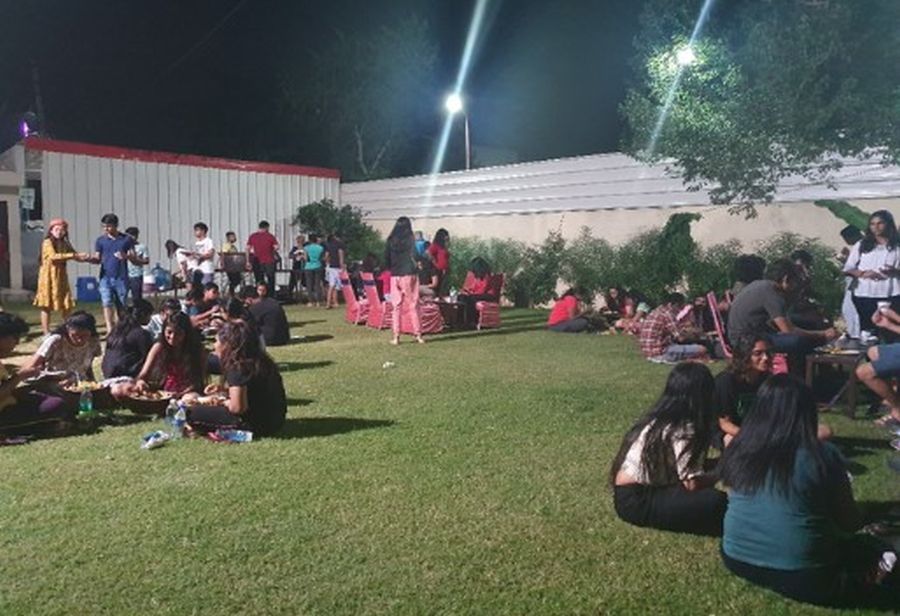 As evening came on the last of us boarded the bus to the last destination of the day: the Jal mahal. I had thought that I was personally too tired to really appreciate it however the Mahal proved me wrong. It was around 6 PM by the time we reached the location and the entire mahal was illuminated with colorful lights. The water reflected the colors making it look like a shiny gemstone shinning through the darkness of the night. Thereafter a short drive later I was finally at the place that I had been looking forward to for the entire day- the markets of Jaipur. I incredibly enjoyed walking through the bustling streets filled with so many colors and handiworks. After an hour of indulging myself holding three bags full of this I realized that it was already 8 PM and apart from having spent a lot of money I was also late by half an hour. As I rushed back towards the tour bus looking forward to the biriyani waiting for me at the hotel, I realized at the end of two short days that in the simplest of words this timed had been absolute bliss and I couldn’t help but feel thankful.
As evening came on the last of us boarded the bus to the last destination of the day: the Jal mahal. I had thought that I was personally too tired to really appreciate it however the Mahal proved me wrong. It was around 6 PM by the time we reached the location and the entire mahal was illuminated with colorful lights. The water reflected the colors making it look like a shiny gemstone shinning through the darkness of the night. Thereafter a short drive later I was finally at the place that I had been looking forward to for the entire day- the markets of Jaipur. I incredibly enjoyed walking through the bustling streets filled with so many colors and handiworks. After an hour of indulging myself holding three bags full of this I realized that it was already 8 PM and apart from having spent a lot of money I was also late by half an hour. As I rushed back towards the tour bus looking forward to the biriyani waiting for me at the hotel, I realized at the end of two short days that in the simplest of words this timed had been absolute bliss and I couldn’t help but feel thankful.
Day 4: Train to Jaisalmer 15014 RANIKHET EXPRESS
Reaching the station at 10 am we waited to board the train scheduled at 11pm while sipping on some chai from the station. It would take us the entire day from Jaipur, expected arrival time at Jaisalmer being around 10:30. The day’s train journey helped us to catch up on some much-needed sleep interrupted by impromptu antakshari sessions and rounds of UNO. As the day drew into the late afternoon the landscape changed drastically, trees were replaced by shrubs as entire sections of land became arid and barren. The lack of moisture in the air could be felt on our cheeks and chapped lips and keeping the water bottle close became increasingly important. By 8 PM our train was in the midst of a full-fledged sandstorm. Quickly shutting all the windows of the the compartment and squinting to combat the low visibility, the realisation hit us all that we had left the comforts of the planes far behind and now sat amidst the deserts of Rajasthan.
At 11:15 we stepped onto the Jaisalmer station, with scarves wrapped tightly around our heads and layers of sand covering us as well as the luggage the team of hundred looked more like makeshift mummies rather than architecture students. Checking into the hotel at midnight the first thing on my to do list was an hour-long shower. Feeling a lot fresher and more rejuvenated I headed to the roof of the hotel where the other team members accompanied by professors sat chatting. The hotel roof as a pretty little space with the parapet wall designed with stone benches that allowed you to sit on the edge of the roof yet not fall of. The nights cool breeze felt pleasing against my wet hair, as I gazed into the distance looking forward to the next day’s activities.
Day 5: City of Jaisalmer
On the itinerary: a) Jaisalmer fort, b) Sam village.
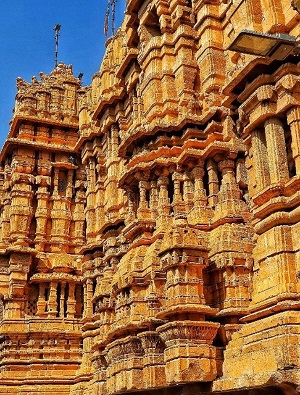 After an early morning breakfast of bread toast, scrambled eggs and fruits we boarded the bus and made our way to Jaisalmer fort. The magnificent complex was built in the year 1156 AD by a Rajput ruler known as Rawal Jaisal. The fort is built on the Trikuta hill which is 80 meters high and surrounded by a wall of 30 feet. Jaisalmer fort is 1,500 ft. (460 m) long and 750 ft. (230 m) wide and is built on a hill that rises above a height of 250 ft. (76 m) above the surrounding countryside. The basement of the fort has a 15 ft. (4.6 m) tall wall forming a double line of defense. The formation of the walled bastions replicates that of the dunes of the sand making it merge into the desert landscape just like the other natural elements. The Jaisalmer fort in the brilliant sunlight appeared to be made of pure gold thus appropriating its popular Bengali name ‘Sonar Kella’.
After an early morning breakfast of bread toast, scrambled eggs and fruits we boarded the bus and made our way to Jaisalmer fort. The magnificent complex was built in the year 1156 AD by a Rajput ruler known as Rawal Jaisal. The fort is built on the Trikuta hill which is 80 meters high and surrounded by a wall of 30 feet. Jaisalmer fort is 1,500 ft. (460 m) long and 750 ft. (230 m) wide and is built on a hill that rises above a height of 250 ft. (76 m) above the surrounding countryside. The basement of the fort has a 15 ft. (4.6 m) tall wall forming a double line of defense. The formation of the walled bastions replicates that of the dunes of the sand making it merge into the desert landscape just like the other natural elements. The Jaisalmer fort in the brilliant sunlight appeared to be made of pure gold thus appropriating its popular Bengali name ‘Sonar Kella’. 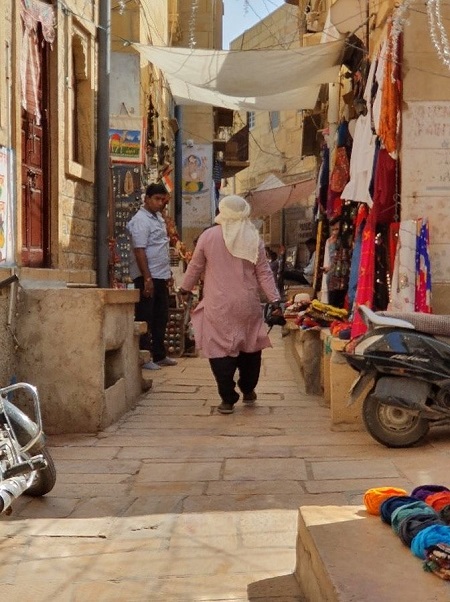
Measure drawing sessions were held at different sections of the fort by the students. Jaisalmer fort apart from being one of the last living forts is also one of the post photogenic places of Rajasthan, be it the extensively ornamental temples or the narrow corridors leading to the small residences, created perfect frames with vibrancy and robustness. The array of colors of the various garments and ornaments being sold against the golden walls is what stays with you long after you have returned.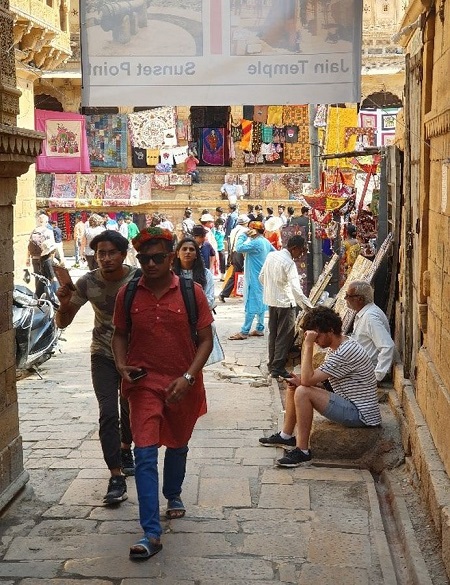
Lunch consisting of rice, roti and several vegetarian curries were served to us back at the hotel. After a quick shower and some rest we repacked our belongings we left to spend the night camping among the desert sands.
On arriving at Sam, we were greeted by camels and jeeps that took us on a joyride across the sand dunes. The camp we would be staying in had small comfortable makeshift tents built around an OAT and a swimming pool.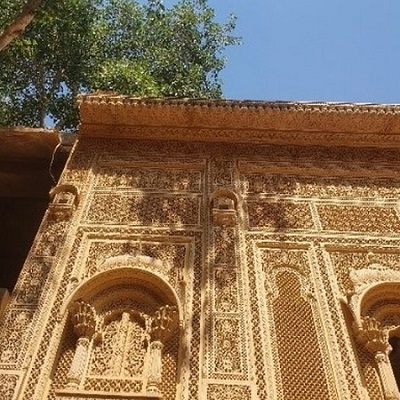
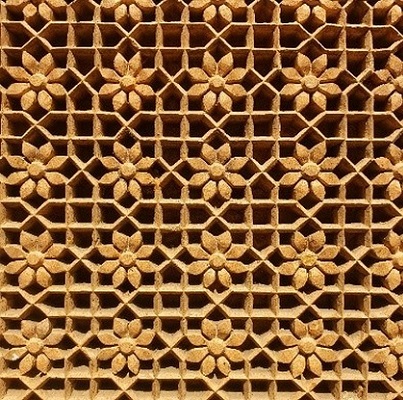
After being greeted by garlands and sweets we made our way to settle down our accommodation for the night. At around 8PM we assembled at the OAT to watch local traditional dances performed by the local women. Dinner consisting of an array of traditional Rajasthani dishes was served here. The night was spend singing and grooving to songs around the bonfire and it wasn’t until late into the night that everyone grudgingly called it a night and finally retired to their beds. The night spent camping among the darkness of the desert out in the wilderness of one of the best nights of the tour.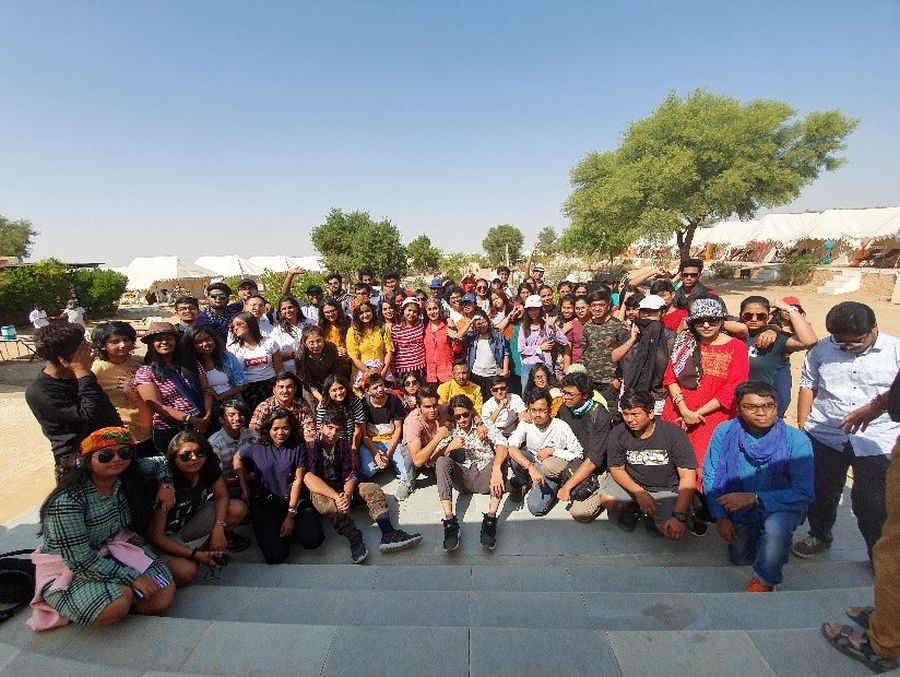
Day 6: City of Jaisalmer
On the itinerary: a) Barabagh, b) Patwon ki Haveli, c) Gaddisar lake.
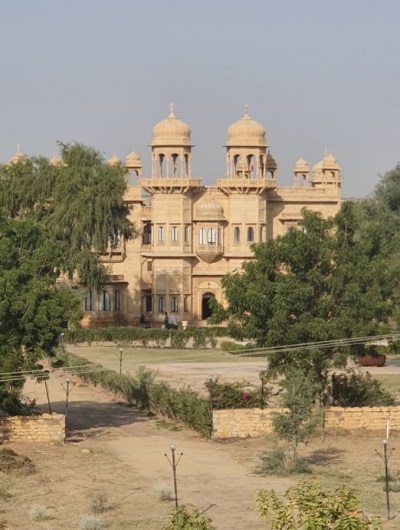 Equidistant from Jaisalmer and Lodhruva, Bada Bagh, literally meaning big garden, features a series of royal cenotaphs or chhatris of Jaisalmer Maharajas, including that of Jai Singh II (Maharaja Sawai Jai Sing). The team reached Badabagh at around 11 AM, The garden consisted of a series of cenotaphs built in order to pay respect to family members of Rajasthan’s royalties. All the chatris despite having the same materials of construction: sandstone, were different in their design and scale.
Equidistant from Jaisalmer and Lodhruva, Bada Bagh, literally meaning big garden, features a series of royal cenotaphs or chhatris of Jaisalmer Maharajas, including that of Jai Singh II (Maharaja Sawai Jai Sing). The team reached Badabagh at around 11 AM, The garden consisted of a series of cenotaphs built in order to pay respect to family members of Rajasthan’s royalties. All the chatris despite having the same materials of construction: sandstone, were different in their design and scale.
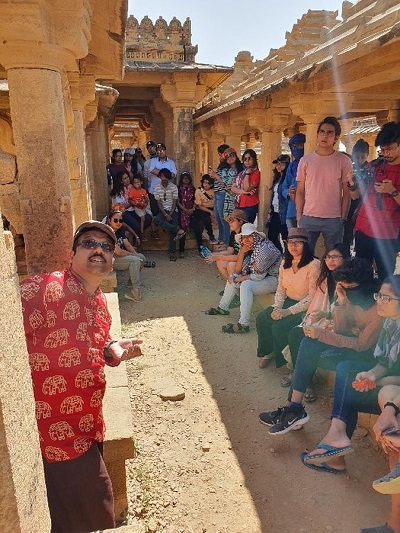
We returned to our hotel by 1 PM and got busy exploring it. Earlier a haveli of the maharaja itself the hotel looked like a small palace in itself, the rooms had high ceilings and grand arched windows and large washrooms complete with bathtubs. After a heavy lunch I settled down into on of the gardens swings admiring the exterior façade treatment of the hotel, feeling nothing less than a maharani myself. Unfortunately enough this bubble of wonderful fiction didn’t last long as I was called onto visit our next destination: Patwon ki haveli
The havelis are also known as the 'mansion of brocade merchants'. This name has been given probably because the family dealt in threads of gold and silver used in embroidering dresses. Located in the center of the city, it is truly an outstanding piece of architecture. Built in red sandstone in the period between 1800 and 1860 AD, it is well known for its beautiful latticework on its porticos made of stone and wood. There is a stunning apartment in it, which is flawlessly painted with beautiful murals. Patwon Ki haveli is renowned for its ornate wall paintings, intricate yellow sandstone-carved jharokhas or balconies, gateways and doorways. Although the building itself is made from yellow sandstone, the main gateway is brown. It is a beautiful Haveli known for its elaborate latticed havelis with facade five-storey building.
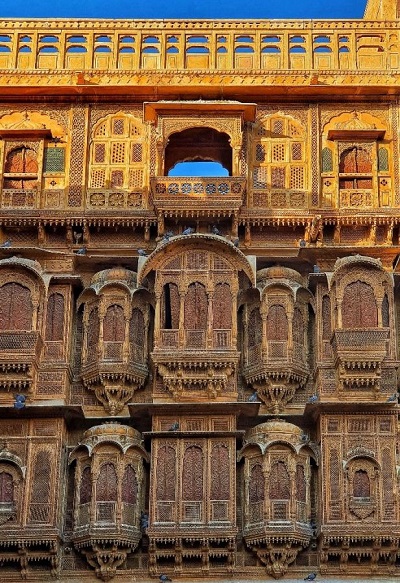 The Patwon Ji ki Haveli is an interesting piece of Architecture and is the most important among the havelis in Jaisalmer. This is precisely because of two things, first that it was the first haveli erected in Jaisalmer and second, that it is not a single haveli but a cluster of 5 small havelis. The first among these havelis was commissioned and constructed in the year 1805 by Guman Chand Patwa and is the biggest and the most ostentatious. It is believed that Patwa was a rich man and was a renowned trader of his time. He could afford and thus ordered the construction of separate stories for each of his 5 sons. These were completed in the span of 50 years. All five houses were constructed in the first 60 years of the 19th century.
The Patwon Ji ki Haveli is an interesting piece of Architecture and is the most important among the havelis in Jaisalmer. This is precisely because of two things, first that it was the first haveli erected in Jaisalmer and second, that it is not a single haveli but a cluster of 5 small havelis. The first among these havelis was commissioned and constructed in the year 1805 by Guman Chand Patwa and is the biggest and the most ostentatious. It is believed that Patwa was a rich man and was a renowned trader of his time. He could afford and thus ordered the construction of separate stories for each of his 5 sons. These were completed in the span of 50 years. All five houses were constructed in the first 60 years of the 19th century.
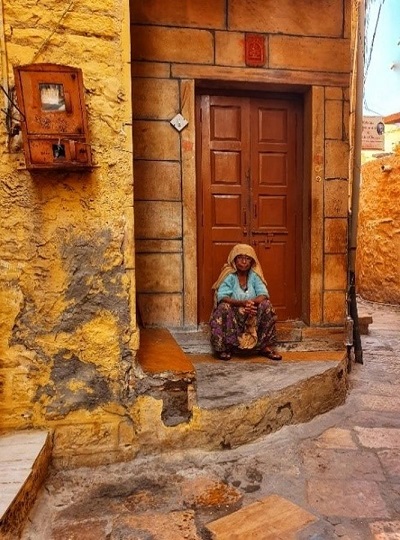 From the Havelis we walked through the narrow lanes of Jaisalmer up until the gadissar lake. Excavated in 1367 by Rawal Gadsi Singh, it is a scenic rainwater lake surrounded by the small temples and shrines of Amar Sagar. Earlier, this lake used to be the main water source of Jaisalmer. Due to an increased water demand for agriculture, the lake is increasingly threatened to dry out. As most of the students decided to scatter into the markets nearby I made my way to the ghats and sat in silence feeding the fish and watching the sun melt into the lake’s water.
From the Havelis we walked through the narrow lanes of Jaisalmer up until the gadissar lake. Excavated in 1367 by Rawal Gadsi Singh, it is a scenic rainwater lake surrounded by the small temples and shrines of Amar Sagar. Earlier, this lake used to be the main water source of Jaisalmer. Due to an increased water demand for agriculture, the lake is increasingly threatened to dry out. As most of the students decided to scatter into the markets nearby I made my way to the ghats and sat in silence feeding the fish and watching the sun melt into the lake’s water.
DAY 7: MOUNT ABU
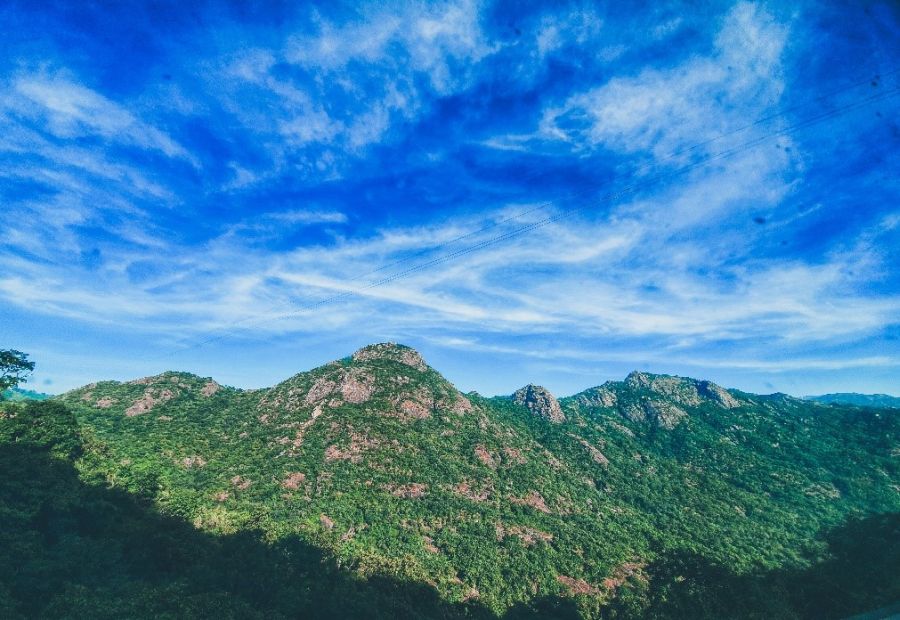 Mount Abu, a small town situated atop the hill with the same name is nestled within the Aravalli range. At a height of 1200 meter it is Rajasthan’s only hill station as well a favorite during the summer months. After an overnight bus journey from Jaisalmer we reached the the outskirts of the town very early in the morning at around 6: AM. After a cup of hot chai at the foot of the hills we set off to travel through the remaining few kilometers between us and our warm hotel beds. The timing was exactly perfect as we managed to watch the entire spectacle of the sun rise from within the Aravalli hills from the comfort of our seats. The bright fresh rays of the sunlight lit up the surrounding bright green forests of the hills creating a vivid contrast of colors with the brilliant cloudless sky. Within a span of forty-five minutes of meandering through the hilly roads the team was finally climbing up the steps leading to the hotel, luggage in hand.
Mount Abu, a small town situated atop the hill with the same name is nestled within the Aravalli range. At a height of 1200 meter it is Rajasthan’s only hill station as well a favorite during the summer months. After an overnight bus journey from Jaisalmer we reached the the outskirts of the town very early in the morning at around 6: AM. After a cup of hot chai at the foot of the hills we set off to travel through the remaining few kilometers between us and our warm hotel beds. The timing was exactly perfect as we managed to watch the entire spectacle of the sun rise from within the Aravalli hills from the comfort of our seats. The bright fresh rays of the sunlight lit up the surrounding bright green forests of the hills creating a vivid contrast of colors with the brilliant cloudless sky. Within a span of forty-five minutes of meandering through the hilly roads the team was finally climbing up the steps leading to the hotel, luggage in hand.
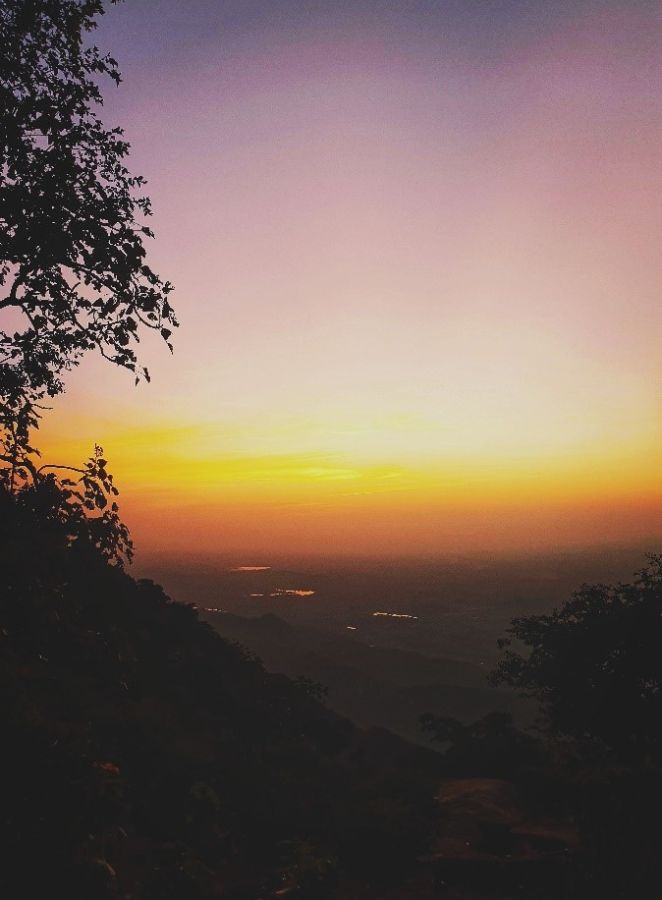 Even though it was just the month of October the temperature had dropped to about 12 degrees. I soaked in the warm sunshine while sitting in the open courtyard of the hotel, a plate of alu paratha in hand, served lovingly by the explorArchi food team. By the time we were done with breakfast everyone had already allotted rooms. The heavy breakfast had made me drowsy and after quickly freshening up I crept under the warm blankets and drifted off peacefully. I woke up to sounds of knocking on my door, a fellow explorArchi team member had come over to call me for lunch. After a light meal at around 2 :30 PM we set out for our first destination of the day: The Dilwara temple complex. The Jain group of temples were built by Vimal Shah and designed by Vastupala trace their origin during the 11-13th century. The architectural style can be categorized as the Nagara. The exterior of these one storey structures is appallingly unremarkable with most of the exterior hidden behind whitewashed walls. Judging by the exterior less informed tourists might even give this famous group of temples a miss. The interior of the temple is the real game changer. Dilwara Temples stand as an example of perfect architecture with intricately carved ceilings, entryways, pillars and panels that reflect the aesthetic appeal of this temple. Regarded as one of the finest specimens of sculptural work, is a storehouse of ancient manuscripts and treatise. The perfection of the engravings done on marble stand as documented proof of the un-replicable skill and hardwork required by the artisans. If Rajasthan had a list of must visit monuments this would the very first to feature there.
Even though it was just the month of October the temperature had dropped to about 12 degrees. I soaked in the warm sunshine while sitting in the open courtyard of the hotel, a plate of alu paratha in hand, served lovingly by the explorArchi food team. By the time we were done with breakfast everyone had already allotted rooms. The heavy breakfast had made me drowsy and after quickly freshening up I crept under the warm blankets and drifted off peacefully. I woke up to sounds of knocking on my door, a fellow explorArchi team member had come over to call me for lunch. After a light meal at around 2 :30 PM we set out for our first destination of the day: The Dilwara temple complex. The Jain group of temples were built by Vimal Shah and designed by Vastupala trace their origin during the 11-13th century. The architectural style can be categorized as the Nagara. The exterior of these one storey structures is appallingly unremarkable with most of the exterior hidden behind whitewashed walls. Judging by the exterior less informed tourists might even give this famous group of temples a miss. The interior of the temple is the real game changer. Dilwara Temples stand as an example of perfect architecture with intricately carved ceilings, entryways, pillars and panels that reflect the aesthetic appeal of this temple. Regarded as one of the finest specimens of sculptural work, is a storehouse of ancient manuscripts and treatise. The perfection of the engravings done on marble stand as documented proof of the un-replicable skill and hardwork required by the artisans. If Rajasthan had a list of must visit monuments this would the very first to feature there.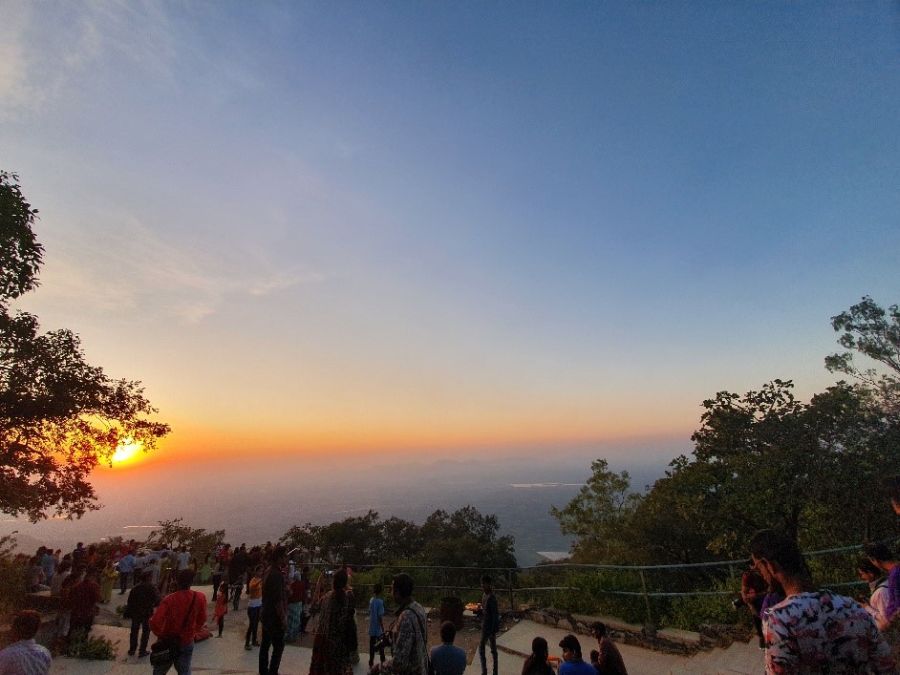 At around 4PM we set of to Mount Abu’s famous sunset point to watch the sky turn into a palette of colors as the sun hid back behind the Aravalli hills. The tour bus dropped us near the Nakki lake which was at a walking distance from our hotel. The artificial lake has a local flea market around it, the evening was spent walking in and out of shops, the famous local chocolate ice cream in hand. Dinner was served at around 9 PM back at the hotel. Students, professors and the explorArchi team gathered in the courtyard for a makeshift karaoke session. As it turns out The explorArchi team leader was quite great singer. Students strummed on their guitar strings and the songs and music carried on till late into the night.
At around 4PM we set of to Mount Abu’s famous sunset point to watch the sky turn into a palette of colors as the sun hid back behind the Aravalli hills. The tour bus dropped us near the Nakki lake which was at a walking distance from our hotel. The artificial lake has a local flea market around it, the evening was spent walking in and out of shops, the famous local chocolate ice cream in hand. Dinner was served at around 9 PM back at the hotel. Students, professors and the explorArchi team gathered in the courtyard for a makeshift karaoke session. As it turns out The explorArchi team leader was quite great singer. Students strummed on their guitar strings and the songs and music carried on till late into the night.
Day 7:
MOUNT ABU TO UDAIPUR: A ROAD TRIP
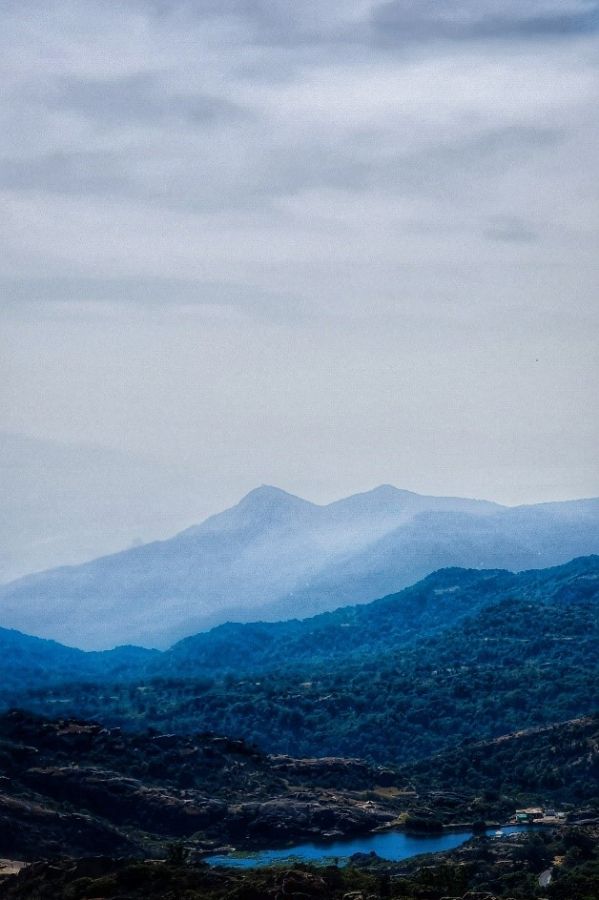 Waking up early morning I rushed to get ready as the entire team prepared to set of to our last destination in Mount Abu: Guru Shikhar. Giving the tour bus a miss, local jeeps were hired to take us up through the narrow hilly roads. Ten minutes into driving the jeep was already outside the cities edges and started to ascend the hills. The town with all its elements surrounding the Nakki Lake kept getting tinier with every passing minute. Guru Shikhar, a peak in the Arbuda Mountains of Rajasthan, is the highest point of the Aravalli Range. It rises to an elevation of 1,722 meters. At the very top is a temple dedicated to Dattatreya, an incarnation of Vishnu. The temple however is only accessible through several flights of stairs. The peak offers the best paranomic views and the photography enthusiasts from the team got busy clicking. In a completely different and quite a funny context there was also a small shop renting out costumes replicating Rajasthani kings and queens. Forgetting about the serious adults we all are everyone of us indulged ourselves and got dresses as in our royal best and got busy clicking the silliest and happiest pictures of the tour.
Waking up early morning I rushed to get ready as the entire team prepared to set of to our last destination in Mount Abu: Guru Shikhar. Giving the tour bus a miss, local jeeps were hired to take us up through the narrow hilly roads. Ten minutes into driving the jeep was already outside the cities edges and started to ascend the hills. The town with all its elements surrounding the Nakki Lake kept getting tinier with every passing minute. Guru Shikhar, a peak in the Arbuda Mountains of Rajasthan, is the highest point of the Aravalli Range. It rises to an elevation of 1,722 meters. At the very top is a temple dedicated to Dattatreya, an incarnation of Vishnu. The temple however is only accessible through several flights of stairs. The peak offers the best paranomic views and the photography enthusiasts from the team got busy clicking. In a completely different and quite a funny context there was also a small shop renting out costumes replicating Rajasthani kings and queens. Forgetting about the serious adults we all are everyone of us indulged ourselves and got dresses as in our royal best and got busy clicking the silliest and happiest pictures of the tour.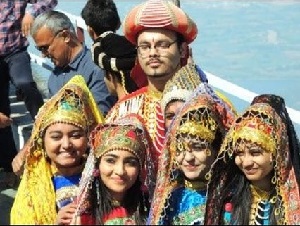
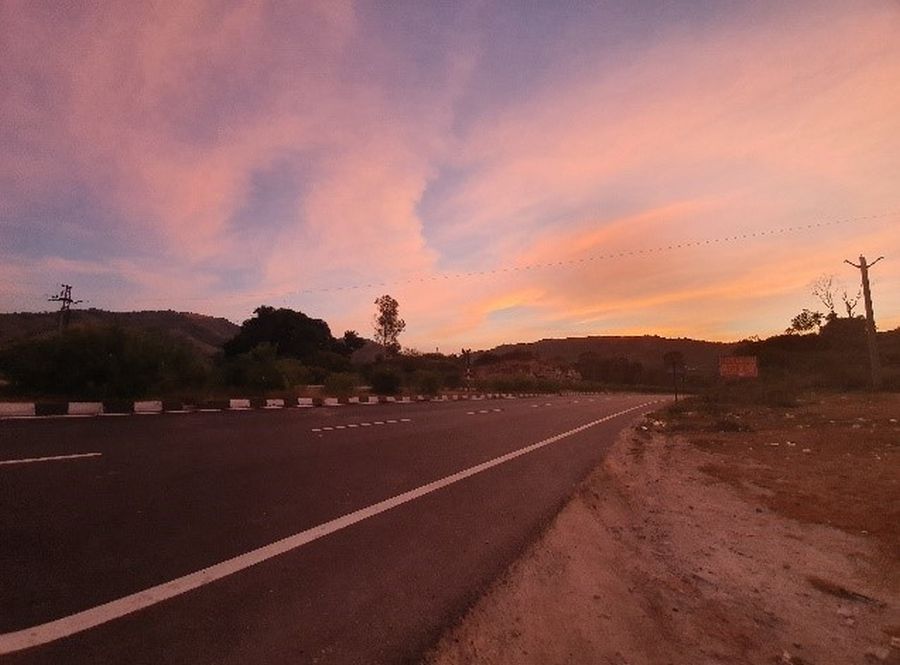 On spending three hours being blown away by the views (and the wind) we made our way back to the town of mount Abu from where we boarded the tour bus that would take us to Udaipur the final city on Rajasthan’s tour itinerary. The journey was spent pleasantly conversing with the professors and the students. At around 8 PM we reached the Udaipur and checked into the hotel. Since this was the last night the entire tour group would be together, a gala dinner had been arranged. We all gathered around staying up late into the night talking merely among ourselves about the wonderful memories had been made and the places we had discovered along the journey, recounting not only the architectural wonders but also the beautiful people that we got aquinted with during this wonderful experience.
On spending three hours being blown away by the views (and the wind) we made our way back to the town of mount Abu from where we boarded the tour bus that would take us to Udaipur the final city on Rajasthan’s tour itinerary. The journey was spent pleasantly conversing with the professors and the students. At around 8 PM we reached the Udaipur and checked into the hotel. Since this was the last night the entire tour group would be together, a gala dinner had been arranged. We all gathered around staying up late into the night talking merely among ourselves about the wonderful memories had been made and the places we had discovered along the journey, recounting not only the architectural wonders but also the beautiful people that we got aquinted with during this wonderful experience.
Day 8:
CITY OF UDAIPUR: JOURNEY ENDS
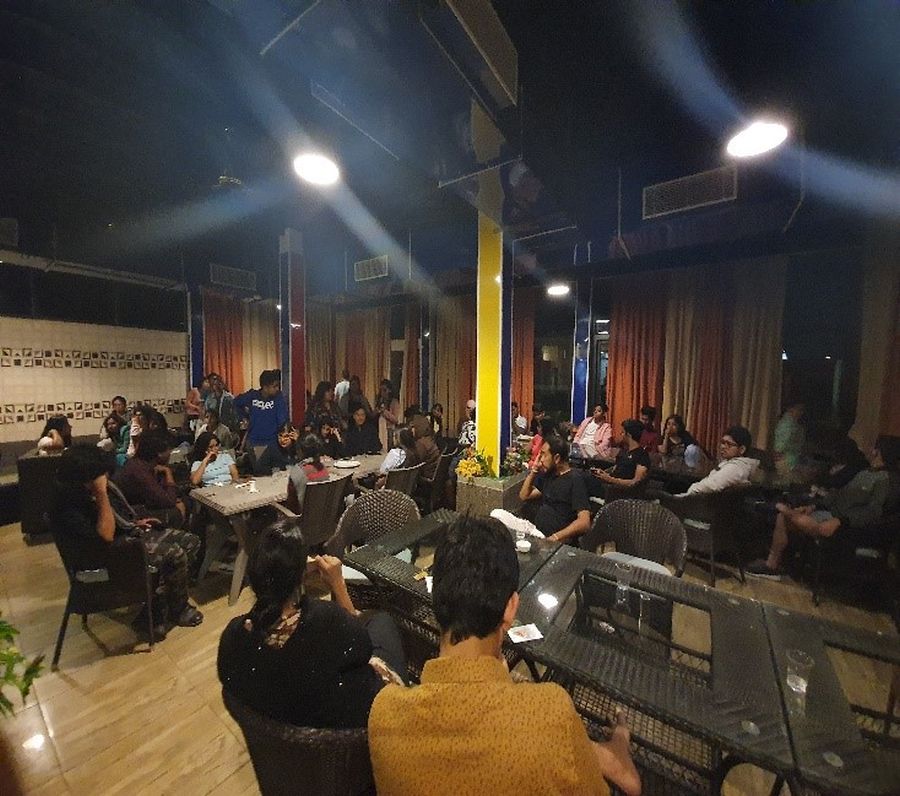 Although we had covered four different cities so far and had travelled through several hundred miles in the last eight days, the tour still seemed to be over in the blink of an eye. It was officially the last day of the tour, however before it all ended three were still two last architectural wonders on the checklist. The first and the most famous was the Udaipur palace. Udaipur was founded in 1553, by Maharana Udai Singh II, the city is popular by the phrase of 'the city of lakes' having a total of eleven such water bodies scattered across the landscape creating an oasis of tranquility. Udaipur City Palace is one of the architectural marvels of Rajasthan, located peacefully on the banks of Lake Pichola. It was built over a period of nearly 400 years, with contributions from several rulers of the Mewar dynasty. Its construction began in 1553, started by Maharana Udai Singh II. City Palace boasts of the wonderful blend of Medieval, European and Chinese Architecture. The series of palaces in the city palace complex, behind an exquisite facade of 244 meters (801 ft.) length and 30.4 meters (100 ft.) height, were built on a ridge on the east of Lake Pichola.
Although we had covered four different cities so far and had travelled through several hundred miles in the last eight days, the tour still seemed to be over in the blink of an eye. It was officially the last day of the tour, however before it all ended three were still two last architectural wonders on the checklist. The first and the most famous was the Udaipur palace. Udaipur was founded in 1553, by Maharana Udai Singh II, the city is popular by the phrase of 'the city of lakes' having a total of eleven such water bodies scattered across the landscape creating an oasis of tranquility. Udaipur City Palace is one of the architectural marvels of Rajasthan, located peacefully on the banks of Lake Pichola. It was built over a period of nearly 400 years, with contributions from several rulers of the Mewar dynasty. Its construction began in 1553, started by Maharana Udai Singh II. City Palace boasts of the wonderful blend of Medieval, European and Chinese Architecture. The series of palaces in the city palace complex, behind an exquisite facade of 244 meters (801 ft.) length and 30.4 meters (100 ft.) height, were built on a ridge on the east of Lake Pichola.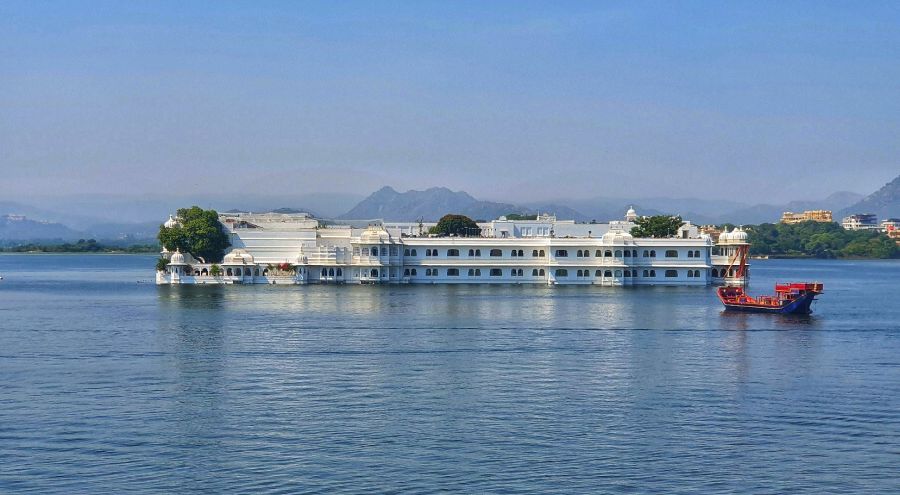
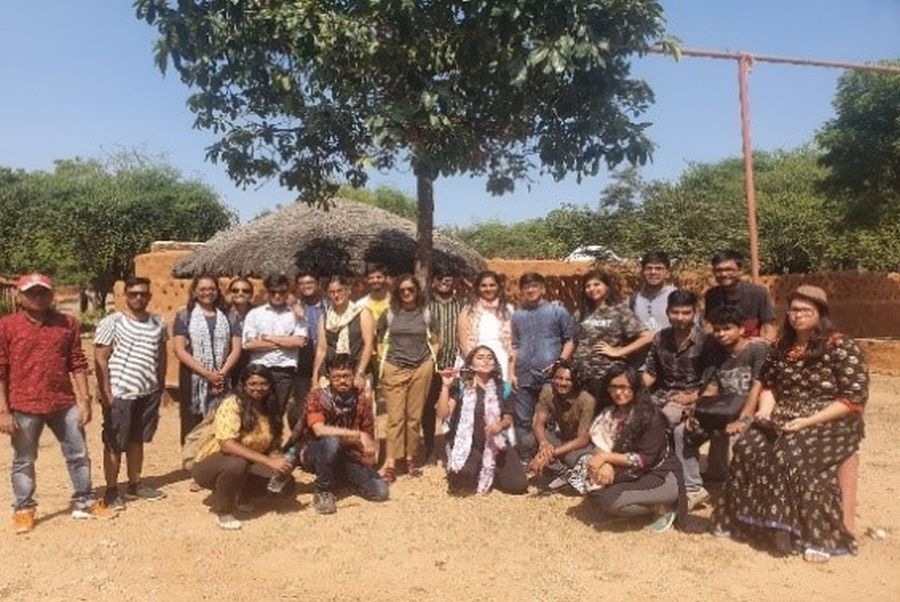 After walking through the different rooms of the palace during the first half of the day, we moved on to our next and last destination: shilpagram in the second half. Shilpgram is a rural arts and crafts complex, situated 3 km (1.9 mi) west of the city of Udaipur, India. Shilpgram is an ethnographic museum that depicts the lifestyles of the folk and tribal people of the region. With an objective of increasing awareness and knowledge about the rural arts and crafts, the Shilpgram provides opportunity to rural and urban artists to come together and interact through the process of camps and workshops The day spent in Udaipur seemed to give a lesson on two very different architectural philosophies, one of grandeur, monumental scale and reaching up to the sky and the other on simplicity, sustainability and the need two go back to one’s roots. The journey and the lessons had in the meantime slowly drawn to a close. As the team boarded the train back to home, we waved goodbye to everyone, it was time to go back to the to living our individual stories again. There was however the hope of one lingering promise: Until next time.
After walking through the different rooms of the palace during the first half of the day, we moved on to our next and last destination: shilpagram in the second half. Shilpgram is a rural arts and crafts complex, situated 3 km (1.9 mi) west of the city of Udaipur, India. Shilpgram is an ethnographic museum that depicts the lifestyles of the folk and tribal people of the region. With an objective of increasing awareness and knowledge about the rural arts and crafts, the Shilpgram provides opportunity to rural and urban artists to come together and interact through the process of camps and workshops The day spent in Udaipur seemed to give a lesson on two very different architectural philosophies, one of grandeur, monumental scale and reaching up to the sky and the other on simplicity, sustainability and the need two go back to one’s roots. The journey and the lessons had in the meantime slowly drawn to a close. As the team boarded the train back to home, we waved goodbye to everyone, it was time to go back to the to living our individual stories again. There was however the hope of one lingering promise: Until next time.
explorArchi is a novel initiative in the Architectural Tourism sector which specializes in conducting personalized educational and architectural tours. Conceptualized by a team of Architects, Engineers and Professionals in 2015, explorArchi provides end-to-end solutions in architectural tours. Our trips are enriched with interactive workshops/ sessions, customized circuit & resource planning, guided tours, food and accommodation, transportation and much more!
Our dynamic and dedicated team of travel-mates are passionate travelers and ardent architecture enthusiasts. The explorArchi team holds extensive experience in architectural tourism and educational excursions having traveled with more than 1400 architecture students so far!
While on tour, we take care of everything. Literally. So, YOU can EXPLORE the ARCHITECTURE!
The City of Lakes is it?
The city of ruins: Mandu
Tourism beyond Covid-19
THE WORLD OF TOURISM!
Why do architecture students need to tour?
Assignment Numero Uno – Journey to the South of India (Tamil Nadu)
explorArchi – A Journey that just began...
9 comments
? ???? ??????????? ?????????? ???? ??? ???????, ?? ????? ????????? ?? ????????????.
seo ?????????? ????? ????
An interesting topic and I'm glad to come across your page where I found some helpful insights. Check out my website QH7 too, if you need additional resources about Cosmetics.
Your ideas absolutely shows this site could easily be one of the bests in its niche. Drop by my website Article World for some fresh takes about SEO. Also, I look forward to your new updates.
Wow, this post has given me useful info and answered some of my questions. I hope to give something back and aid others like you helped me. Feel free to surf my website 48U about Internet Marketing.
Amazing Content! If you need some details about about SEO than have a look here Article Home
Wow, this post has given me useful info and answered some of my questions. I hope to give something back and aid others like you helped me. Feel free to surf my website 59N about Cosmetics.
Wow, this post has given me useful info and answered some of my questions. I hope to give something back and aid others like you helped me. Feel free to surf my website Seoranko about Data Mining.
This is top-notch! I wonder how much effort and time you have spent to come up with these informative posts. Should you be interested in generating more ideas about Bitcoin, take a look at my website Webemail24